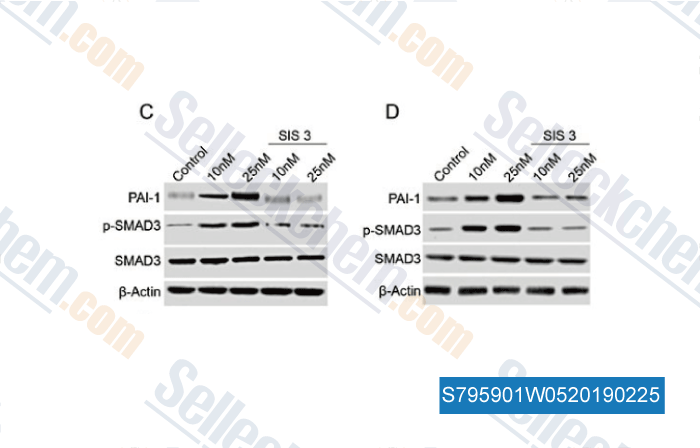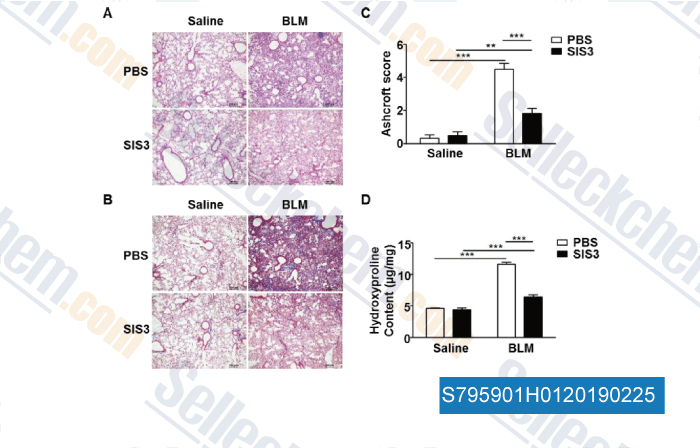|
Toll Free: (877) 796-6397 -- USA and Canada only -- |
Fax: +1-832-582-8590 Orders: +1-832-582-8158 |
Tech Support: +1-832-582-8158 Ext:3 Please provide your Order Number in the email. |
Technical Data
| Formula | C28H27N3O3.HCl |
||||||
| Molecular Weight | 489.99 | CAS No. | 521984-48-5 | ||||
| Solubility (25°C)* | In vitro | DMSO | 98 mg/mL (200.0 mM) | ||||
| Water | Insoluble | ||||||
| Ethanol | Insoluble | ||||||
| In vivo (Add solvents to the product individually and in order) |
|
||||||
|
* <1 mg/ml means slightly soluble or insoluble. * Please note that Selleck tests the solubility of all compounds in-house, and the actual solubility may differ slightly from published values. This is normal and is due to slight batch-to-batch variations. * Room temperature shipping (Stability testing shows this product can be shipped without any cooling measures.) |
|||||||
Preparing Stock Solutions
Biological Activity
| Description | SIS3, a novel specific inhibitor of Smad3, inhibits TGF-β and activin signaling by suppressing Smad3 phosphorylation without affecting the MAPK/p38, ERK, or PI3-kinase signaling pathways. | |
|---|---|---|
| Targets |
|
|
| In vitro | Addition of SIS3 attenuates the effects of TGF-β1 by reducing the transcriptional activity. SIS3 also inhibits the myofibroblast differentiation of fibroblasts by TGF-β1. SIS3 completely diminishes the constitutive phosphorylation of Smad3 as well as the up-regulated type I collagen expression in scleroderma fibroblasts, thus abolishes the ECM overexpression in the TGF-β1-treated normal dermal fibroblasts and scleroderma fibroblasts in vitro[1]. | |
| In vivo | SIS3 inhibits Smad3 activation in streptozotocin(STZ)-induced diabetic nephropathy in Tie2-Cre;Loxp-EGFP mice. It also reduces AGE-induced EndoMT and decreases EndoMT in STZ-induced diabetic nephropathy in Tie2-Cre;Loxp-EGFP mice. SIS3 significantly reduces collagen IV and fibronectin expression in the glomeruli and tubulointerstitium of STZ-injected Tie2-Cre;Loxp-EGFP mice, suggesting that SIS3 retards the early development of STZ-induced diabetic glomerulosclerosis and tubulointerstitial fibrosis. However, SIS3 administration does not reduce proteinuria[2]. |
Protocol (from reference)
| Cell Assay: |
|
|---|---|
| Animal Study: |
|
References
|
Customer Product Validation

-
, , Circ Res, 2017, 121(6):617-627

-
Data from [Data independently produced by , , Cell Physiol Biochem, 2017, 44(6):2201-2211]

-
Data from [Data independently produced by , , Lab Invest, 2018, doi: 10.1038/s41374-018-0091-y]

-
Data from [Data independently produced by , , Biochem Biophys Res Commun, 2018, 503(2):757-762]
Selleck's SIS3 HCl has been cited by 91 publications
| KLHL25-ACLY module functions as a switch in the fate determination of the differentiation of iTreg/Th17 [ Commun Biol, 2025, 8(1):471] | PubMed: 40119138 |
| UBR5 mediates colorectal cancer chemoresistance by attenuating ferroptosis via Lys 11 ubiquitin-dependent stabilization of Smad3-SLC7A11 signaling [ Redox Biol, 2024, 76:103349] | PubMed: 39260061 |
| Vulnerability to APOBEC3G linked to the pathogenicity of deltaretroviruses [ Proc Natl Acad Sci U S A, 2024, 121(13):e2309925121] | PubMed: 38502701 |
| Vulnerability to APOBEC3G linked to the pathogenicity of deltaretroviruses [ Proc Natl Acad Sci U S A, 2024, 121(13):e2309925121] | PubMed: 38502701 |
| Therapeutic targeting of PLK1 in TERT promoter-mutant hepatocellular carcinoma [ Clin Transl Med, 2024, 14(5):e1703] | PubMed: 38769666 |
| Therapeutic targeting of PLK1 in TERT promoter-mutant hepatocellular carcinoma [ Clin Transl Med, 2024, 14(5):e1703] | PubMed: 38769666 |
| Treatment for type 2 diabetes and diabetic nephropathy by targeting Smad3 signaling [ Int J Biol Sci, 2024, 20(1):200-217] | PubMed: 38164169 |
| Sleeve gastrectomy links the attenuation of diabetic kidney disease to the inhibition of renal tubular ferroptosis through down-regulating TGF-β1/Smad3 signaling pathway [ J Endocrinol Invest, 2024, 10.1007/s40618-023-02267-1] | PubMed: 38512446 |
| Smad3 is essential for polarization of tumor-associated neutrophils in non-small cell lung carcinoma [ Nat Commun, 2023, 14(1):1794] | PubMed: 37002229 |
| Smad3 is essential for polarization of tumor-associated neutrophils in non-small cell lung carcinoma [ Nature Communications-, 2023, 1794-2023)] | PubMed: None |
RETURN POLICY
Selleck Chemical’s Unconditional Return Policy ensures a smooth online shopping experience for our customers. If you are in any way unsatisfied with your purchase, you may return any item(s) within 7 days of receiving it. In the event of product quality issues, either protocol related or product related problems, you may return any item(s) within 365 days from the original purchase date. Please follow the instructions below when returning products.
SHIPPING AND STORAGE
Selleck products are transported at room temperature. If you receive the product at room temperature, please rest assured, the Selleck Quality Inspection Department has conducted experiments to verify that the normal temperature placement of one month will not affect the biological activity of powder products. After collecting, please store the product according to the requirements described in the datasheet. Most Selleck products are stable under the recommended conditions.
NOT FOR HUMAN, VETERINARY DIAGNOSTIC OR THERAPEUTIC USE.
